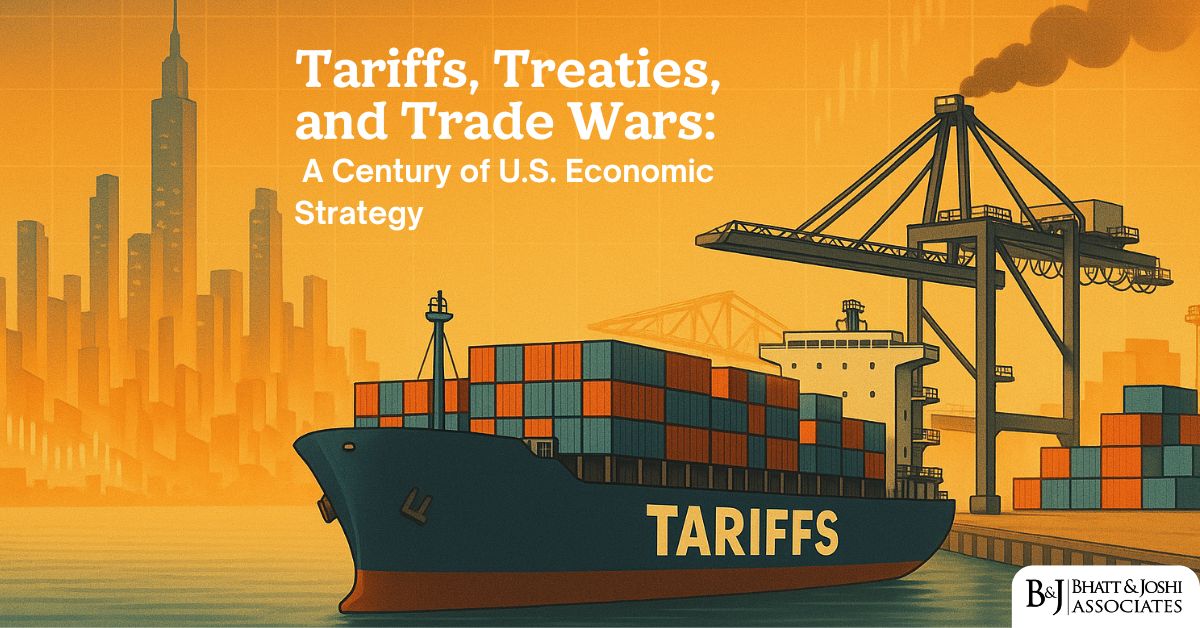Introduction
The evolution of American trade policy over the past century tells a compelling story of economic transformation, strategic adaptation, and changing global realities. From the heights of protectionism in the early 20th century through the embrace of free trade in the post-war era, and now to the current period of strategic trade policy, the United States has continuously adjusted its approach to international commerce in response to changing circumstances and national priorities. This broad historical trajectory encapsulates the century of U.S. trade policy, which has been shaped by both domestic imperatives and global economic forces.
This journey reflects not just economic considerations but also broader strategic imperatives, domestic political pressures, and shifting international power dynamics. Understanding this complex history is crucial for evaluating current policy choices and anticipating future developments in U.S. trade strategy.
Early 20th Century Trade Policy
The early decades of the 20th century were marked by strong protectionist sentiment in American trade policy, culminating in the infamous Smoot-Hawley Tariff Act of 1930. This legislation raised tariffs on thousands of imported goods to unprecedented levels, averaging between 45 and 50 percent. The act represented the apex of American protectionism and proved to be a catastrophic policy mistake, contributing to a massive decline in global trade and deepening the Great Depression.
The fallout from Smoot-Hawley fundamentally altered American thinking about trade policy. As global trade collapsed by approximately two-thirds between 1929 and 1934, and trading partners enacted retaliatory tariffs, policymakers began to recognize the dangers of extreme protectionism. This experience profoundly influenced subsequent U.S. trade policy, becoming an early turning point in the broader Century of U.S. Trade Policy that would evolve in response to global economic challenges. The shift in approach led to the Reciprocal Trade Agreements Act of 1934, which marked the beginning of a more cooperative and reciprocal approach to international commerce.
The Great Depression’s impact on trade policy extended beyond immediate legislative changes. It fostered a growing understanding of international economic interdependence and the need for coordinated policy responses to economic challenges. The development of Keynesian economic theories during this period provided intellectual foundations for more sophisticated approaches to international economic management.
The Post-War Liberal Order
The aftermath of World War II presented an unprecedented opportunity to reshape the international economic order. The United States, emerging from the war with unparalleled economic strength, took the lead in establishing new institutions and rules for international economic cooperation. The Bretton Woods Conference of 1944 created the fundamental architecture of the post-war economic system, establishing the International Monetary Fund and the World Bank while laying groundwork for what would become the General Agreement on Tariffs and Trade (GATT).
This new system represented a remarkable departure from pre-war economic nationalism. The United States, recognizing its unique position and responsibilities, promoted a liberal international economic order based on multilateral cooperation and progressive trade liberalization. The system combined fixed exchange rates anchored to the dollar (and ultimately to gold) with mechanisms for promoting international trade and investment.
The GATT, established in 1947, became the cornerstone of the new trading system. Through successive rounds of negotiations, it provided a framework for steady reduction in trade barriers while establishing crucial principles like non-discrimination and most-favored-nation treatment. The system proved remarkably successful in promoting trade growth and economic recovery among participating nations.
The Rise of Trade Agreements
The 1960s and 1970s saw a significant evolution in trade policy approaches. The Trade Expansion Act of 1962 granted unprecedented authority for trade negotiations, enabling the Kennedy Round of GATT talks. This period marked the beginning of more comprehensive approaches to trade policy, moving beyond simple tariff reductions to address non-tariff barriers and other complex trade issues.
The Tokyo Round of GATT negotiations (1973-1979) represented a major advance in trade policy sophistication. Negotiators tackled complex issues like government procurement, technical barriers to trade, and subsidies. These discussions reflected the growing complexity of international trade relationships and the need for more nuanced policy tools.
The Uruguay Round (1986-1994) marked another watershed in trade policy evolution. These negotiations led to the creation of the World Trade Organization (WTO), expanding trade rules to cover services, intellectual property, and agriculture while establishing stronger dispute settlement mechanisms. This represented the high point of the post-war liberal trading order, creating a comprehensive framework for managing international trade relations.
Regional Trade Developments
The 1990s saw the emergence of regional trade agreements as a major feature of U.S. trade policy. The North American Free Trade Agreement (NAFTA), implemented in 1994, created the world’s largest free trade area at that time. NAFTA represented a new model of deep economic integration, addressing not just tariffs but also investment, services, intellectual property, and other aspects of economic relations.
The United States pursued similar agreements with other regions, developing trade relationships with Asian economies and negotiating agreements with European partners. These regional arrangements complemented multilateral efforts through the WTO while allowing for deeper integration with key trading partners.
China Trade Relations
The evolution of U.S.-China trade relations represents one of the most significant developments in American trade policy over the past half-century. Beginning with Nixon’s opening to China in 1972, the relationship transformed from limited engagement to deep economic interdependence. The decision to grant China Permanent Normal Trade Relations (PNTR) in 2000 and support its WTO accession in 2001 marked a pivotal moment in this transformation, based on the belief that economic engagement would promote both market reforms and political liberalization in China.
These expectations proved overly optimistic. While trade with China expanded dramatically, growing from approximately $100 billion in 2000 to over $650 billion by 2020, the relationship became increasingly problematic. China’s state-directed economic model, coupled with industrial policies aimed at developing strategic sectors, created tensions that the existing trade framework struggled to address. Issues of intellectual property theft, forced technology transfer, and state subsidies became persistent sources of friction.
The relationship’s complexity deepened as China emerged as both a crucial economic partner and a strategic competitor. American companies became heavily dependent on Chinese manufacturing and markets, while China used its growing economic power to pursue strategic objectives that often conflicted with U.S. interests. This duality created policy challenges that traditional trade tools were ill-equipped to address.
Modern Trade Conflicts
The Trump administration’s approach to trade policy marked a decisive break with decades of U.S. trade orthodoxy. Implementing tariffs under Section 232 (national security) and Section 301 (unfair trade practices) of U.S. trade law, the administration initiated trade conflicts not just with China but also with traditional allies. These actions reflected growing frustration with existing trade arrangements and a belief that more aggressive measures were needed to protect U.S. economic interests.
The trade war with China, beginning in 2018, represented one of the most consequential shifts in the century of U.S. trade policy, echoing tensions not seen since the 1930s. Tariffs affecting hundreds of billions of dollars in bilateral trade demonstrated both the scale of economic tensions and the limits of traditional trade policy tools. The Phase One agreement of January 2020, while providing temporary stabilization, left fundamental issues unresolved.
The Biden administration has maintained many Trump-era tariffs while seeking to build international coalitions to address China-related challenges. This approach reflects a broader recognition that traditional free trade policies require modification to address strategic competition and economic security concerns. The focus has shifted toward “worker-centered” trade policy and strengthening domestic industrial capabilities in strategic sectors.
Future Policy Directions for U.S. Trade Policy
Current U.S. trade policy reflects a fundamental reassessment of traditional approaches. The emphasis on supply chain resilience, revealed as crucial during the COVID-19 pandemic, has led to initiatives like the CHIPS and Science Act of 2022, providing substantial support for domestic semiconductor manufacturing. This represents a more activist industrial policy than the U.S. has pursued in recent decades.
The concept of “friend-shoring” – relocating supply chains to allied or friendly nations – has emerged as an alternative to both complete reshoring and continued dependence on strategic competitors. This approach seeks to balance economic efficiency with security concerns, recognizing that complete decoupling from China is neither practical nor desirable.
Environmental and labor standards have gained prominence in trade policy considerations. The U.S.-Mexico-Canada Agreement (USMCA), replacing NAFTA, includes strengthened labor provisions and environmental protections, potentially setting precedents for future trade agreements. These developments suggest a more comprehensive approach to trade policy that extends beyond traditional commercial considerations.
Strategic Implications of U.S. Trade Policy
The evolution of U.S. trade policy carries significant implications for the global economic order. The shift away from pure free trade principles toward strategic considerations reflects broader changes in the international system. The challenge lies in maintaining the benefits of international trade while addressing legitimate national security and economic resilience concerns.
Investment screening mechanisms, such as the expanded Committee on Foreign Investment in the United States (CFIUS), represent one approach to balancing openness with security. Export controls on critical technologies have also gained renewed importance as tools of economic statecraft. These measures suggest a more nuanced approach to economic integration, recognizing both its benefits and potential risks.
Conclusion
A century of U.S. trade policy reveals a dynamic interplay between economic ideology, strategic imperatives, and practical necessities. The current moment represents not so much a return to protectionism as a recalibration of trade policy to address contemporary challenges. The key question facing policymakers is not whether to engage in international trade but how to structure that engagement to serve both economic and strategic objectives.
The path forward likely involves a hybrid approach that maintains commitment to international trade while incorporating stronger protections for strategic industries and national security interests. Success will require careful balance between competing priorities: maintaining economic efficiency, ensuring security, promoting innovation, and protecting domestic industries and workers.
The lessons of the past century suggest that neither pure protectionism nor unrestricted free trade provides adequate answers to current challenges. The future of U.S. trade policy lies in developing sophisticated approaches that can navigate between these extremes while addressing the complex realities of modern global commerce. This evolution continues to shape both American economic prospects and the broader international order.














